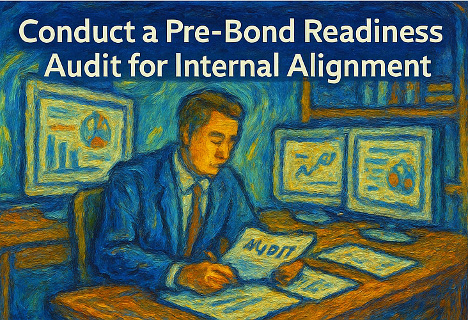“Success depends upon previous preparation, and without such preparation there is sure to be failure.”
— Confucius
3 Things Every Municipality Should Do Before Launching a Bond Program
Launching a municipal bond program is a major undertaking that can shape a county’s future for decades. Whether funding critical infrastructure, new facilities, or community improvements, a bond program requires careful groundwork to ensure success. County managers, finance directors, and council members must be confident that everything is in place before the first bond is issued or the measure goes to voters. The following are three key steps every municipality should address before launching a bond program. These steps will help align your team, solidify your plan, and avoid costly surprises down the road.

- Establish Clear Project Priorities and Alignment with County Goals
Before diving into the financing details, take a step back and make sure the bond program’s vision and scope are crystal clear. This means defining exactly which projects will be funded and ensuring those projects align with the community’s long-term plans and priorities. Start with your county’s Capital Improvement Plan (CIP) or strategic infrastructure plan – are the projects you intend to fund with the bond clearly identified and ranked in terms of priority? All key stakeholders (department heads, council members, and community leaders) should agree on the project list and its alignment with the county’s goals.
Why this matters: If there is ambiguity or last-minute disagreement about what the bond money should cover, it can derail the program. For example, imagine launching a bond initiative thinking it will fund a new water treatment plant, only to have community leaders push for those funds to go to road repairs instead. Lack of upfront consensus can lead to public confusion, eroded trust, and even project delays or reallocations. By contrast, when everyone is on the same page from the start, the bond program can be presented to the public with confidence and transparency – “Here is exactly what we plan to do and why it matters.” This clarity not only helps build public support but also guides all subsequent decisions in the bond process.
How to do it: Convene planning sessions to review and confirm the project list. Use data and community input to prioritize needs – for instance, infrastructure report cards, master plans, and citizen feedback can inform what’s most urgent. Ensure each project supports broader policy goals (e.g. economic development, public safety, regulatory compliance) and document these links. It often helps to prepare a concise Bond Program Brief that lists the projects, timelines, and expected outcomes. County council should formally approve this scope to lock in consensus. Taking the time to solidify “what we’re funding and why” provides a strong foundation on which the rest of the bond program is built.

- Strengthen Your Financial and Legal Foundation
With a clear vision in place, the next focus is financial and legal readiness. A bond program will only be as successful as the soundness of the financing behind it. Municipal leaders must ensure that the county’s financial house is in order and all legal requirements are met before bonds are put on the ballot or taken to market.
Start by assessing your county’s debt capacounty and credit health. How much additional debt can the municipality handle given its current obligations and revenue streams? It’s important to calculate the impact of the new bond program on metrics like debt service coverage, credit ratings, and, if relevant, property tax rates. Many cities conduct a debt affordability analysis or work with financial advisors to project the long-term costs of the bond and how they will be paid. For example, if bonds will be repaid via property taxes, leaders should forecast the tax rate implications and ensure they align with what was communicated to voters or residents. Nobody likes surprises such as an unexpected tax hike or budget squeeze because the financing plan was flawed.
Ensure you have a master funding and cash flow plan. Map out when bond funds will be needed and in what amounts, based on the project schedules. This helps determine the timing and sizing of bond issuances. Perhaps your county will issue the bonds in phases (e.g. a series of bond sales over several years) – your cash flow plan should align bond proceeds with project expenditures. This avoids borrowing too much too early (and paying interest on idle funds) or too little too late (and stalling a project due to lack of funds). A strong master cash flow plan ties the financial side to the project side seamlessly.
On the legal front, make sure all statutory and regulatory requirements are addressed ahead of time. Different types of municipal bonds (General Obligation, Revenue, etc.) have different approval processes. Does your bond program require voter approval through a referendum? If so, plan the election timeline and public information campaign well in advance. If it’s council-approved debt, ensure the ordinances or resolutions authorizing the bonds are drafted correctly and meet your state’s laws. Also, consider any bond policy updates: for instance, many municipalities have a debt management policy – does it need revision before taking on new debt? Ensuring legal compliance early protects the program from challenges or delays later (such as a lawsuit claiming the bond was not properly authorized).
Don’t forget to engage with credit rating agencies and financial advisors early in the process. A proactive approach – like meeting with rating analysts to present your capital plans and financial strategies – can bolster confidence and potentially secure a better credit rating. A higher credit rating means lower interest rates, which can save taxpayers significant money over the life of the bond. Conversely, if a county skips this prep work and rushes to market, it might encounter higher borrowing costs or investor concerns if its financial picture isn’t clearly communicated. In short, double-check the numbers and the rules: make sure the financing plan is solid and all legal boxes are checked before launching your bond program.

- Conduct a Pre-Bond Readiness Audit for Internal Alignment
Once your projects are chosen and your financial plan is mapped out, one critical step remains: ensuring your organization is internally prepared to execute the bond program efficiently. This is where a pre-bond readiness audit comes in. The idea is to perform a thorough audit or review of all relevant internal systems, processes, and policies before the bond program kicks off. The goal is to ensure complete alignment across departments – from public works and engineering to finance and IT – so that once funds are available, everyone can hit the ground running without costly hiccups.
A pre-bond readiness audit typically checks alignment across several key areas:
- Infrastructure Management Systems (IMS) and project databases: Are the systems that track capital projects and infrastructure assets up-to-date and consistent with the bond program’s project list? For example, if your public works department uses a pavement management system or asset registry, the data (like project cost estimates or condition ratings) in those systems should match the assumptions in the bond plan. Discrepancies here could mean a project was planned with outdated information, leading to budget shortfalls or scope changes later.
- Master cash flow planning: This ties into the financial planning above – the audit ensures that the projected cash flows (when funds will be needed for each project) are realistic and agreed upon by both project managers and finance staff. It’s a final check that, say, the engineering team’s construction schedule for a new bridge is synchronized with the finance team’s schedule for bond fund availability. Any misalignment could cause either idle cash sitting unused or a project waiting on funds – both scenarios carry costs and inefficiencies.
- Software platforms and data integration: Modern municipalities use various software platforms (financial management software, project management tools, procurement systems, etc.). The audit verifies that these platforms are ready to handle the new bond program. For instance, can your financial system segregate and track bond funds separately? Is your project management software configured to report on bond-funded projects? Ensuring interoperability and data consistency between platforms is crucial. If the finance department is using one set of software and public works another, the audit will flag any integration needs so that everyone is working from the same information once the program starts.
- Processes and policy decisions: Finally, the audit reviews the processes that will govern the bond program’s execution. This includes everything from procurement policies (are bidding and contracting procedures in place to handle the surge of projects?) to reporting and oversight structures (how will progress be reported to leadership and the public?). It’s important that basic policy decisions – such as how change orders are approved or how interest earnings on unspent bond funds are handled – are decided upfront. Clear, agreed-upon processes prevent confusion mid-project. For example, if departments disagree on who has authority to approve a construction change, that could halt work and waste time until resolved. An audit makes sure such policies are already settled and documented.
The benefit: Conducting this kind of readiness audit forces a municipality to iron out any internal wrinkles before they can cause delays or cost overruns. It’s much cheaper and easier to fix an issue now – say a software configuration or a process gap – than when you’re in the middle of an active bond program with contractors mobilized and citizens expecting results. When every system and team is aligned, the county can avoid the “left hand doesn’t know what the right hand is doing” syndrome. Instead, there’s a shared understanding across all departments about how the bond program will proceed.
Municipalities that have taken this step often find that it saves significant time and money once the bond projects are underway. In fact, some cities hire external experts to perform a pre-bond readiness audit for an objective look at their preparedness. (For example, FLAG, a firm specializing in municipal advisory services, offers a dedicated pre-bond readiness audit. Cities that utilized this service have reported saving substantial time and avoiding costly mistakes by catching misalignments early in the process.) Even if you conduct the audit in-house, the key is to involve all relevant departments and leadership in reviewing the findings and agreeing on any needed fixes or adjustments before the bond program launch. The result will be a smoother execution phase with far fewer headaches.
Conclusion: Launching a bond program isn’t just about securing funding – it’s about delivering on promises to your community. By establishing clear priorities, ensuring financial/legal readiness, and aligning internal systems through a readiness audit, county leaders can set their bond programs up for success. These preparatory steps help prevent the common pitfalls that lead to delays, budget overruns, or public distrust. Municipal bond initiatives can span many years and involve many moving parts; a proactive approach to planning and coordination is essential. Before you cut the ribbon on a new bond program, make sure the groundwork is in place. With a solid foundation under you, your county will be well-positioned to build the projects residents are counting on – efficiently, transparently, and on target to meet the community’s needs for years to come.
Front Line Advisory Group (FLAG) is a Program Management Consulting (PMC) firm focused on delivering bond-funded infrastructure projects on time and on budget through disciplined management and data-driven controls. Our mission extends beyond consultation – we empower our clients to realize the full potential of their investments, ensuring tax dollars are put to maximum use through astute Program Management Consulting. For more information or to commence your journey towards transformative bond management, reach out to us at Info FLAG
Bibliography
- Government Finance Officers Association (GFOA). (2021). Best Practices: Capital Planning Policies. Retrieved from https://www.gfoa.org/capital-planning-policies
- Municipal Securities Rulemaking Board (MSRB). (2020). Understanding Municipal Bonds: A Guide for Public Officials. Retrieved from https://www.msrb.org
- National Association of State Budget Officers (NASBO). (2022). State Expenditure Report: Examining Fiscal 2020-2022 State Spending. Retrieved from https://www.nasbo.org
- International City/County Management Association (ICMA). (2023). Building Capital Improvement Programs That Support Long-Term Community Goals. Retrieved from https://icma.org
- Standard & Poor’s Global Ratings. (2023). U.S. Public Finance: Methodology for Rating General Obligation Bonds. Retrieved from https://www.spglobal.com/ratings/en
- Front Line Advisory Group (FLAG). (2024). Pre-Bond Readiness Audit Overview: Aligning Policy, Process, and Execution for Successful Bond Programs. Internal publication, FLAG Advisory Services.













